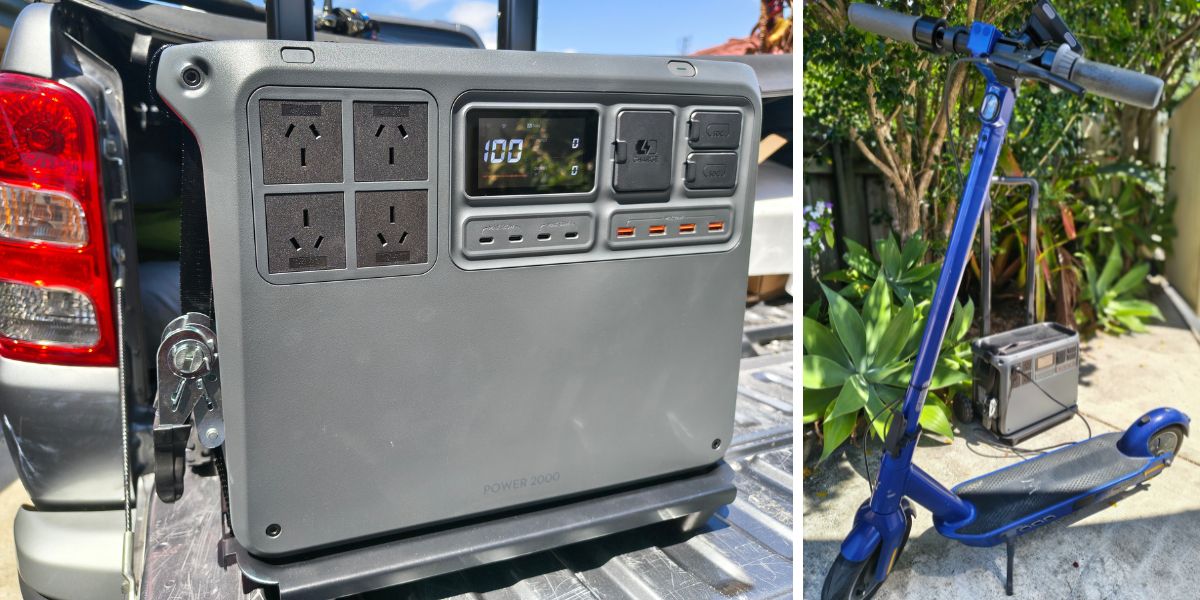Over the years I’ve learned to appreciate the simple joys of nature, there’s nothing better than a good old camping trip and especially at this time of year where it’s not too hot and not too cold, but just right for toasting marshmallows by the campfire. I’ll be the first to admit though that my version of “roughing it” often includes just a few modern comforts. Call it glamping, call it being prepared, I call it enjoying the best of both worlds.
The biggest challenge has always been power. Keeping cameras charged, running a portable fridge, or even just powering a string of lights to make the campsite feel like home requires a serious energy source. For years, this meant noisy generators or juggling a collection of smaller, inadequate battery packs. Then, I discovered the DJI Power 2000 and it changed my entire approach to off-grid comfort.



First Impressions: Big Power, Not-So-Big Package
DJI, a brand I’ve long associated with high-image-quality drones and action cameras, I assume created the initial Power 1000 as a solution to drone operation in the field, but as the product evolved what they have actually ended up with is something far more compelling. The Power 2000 is their new, higher-capacity model, and it’s clear they’ve designed it with more demanding users in mind.
Pulling the unit from its box, the first thing I noticed was its thoughtful design. Weighing in at around 22 kg. I’m not a big guy, so it’s substantial but manageable especially when you pair it with the optional DJI Power Series Hand Truck which is a compact trolley I would consider a must-buy for your unit.
Its form factor is akin to a mini carry-on suitcase, measuring just 16 inches, which means it slides easily into the back of my Triton without commandeering all the space reserved for my Eski, tent, kids bikes and everything else we need to take. The ports, buttons, and display are all neatly integrated on the front panel, making it easy to access if you position it right so that everything is facing a direction that you can use it from in a cramped tent or vehicle.



Putting It to the Test: Powering the Modern Campsite
The spec sheet is impressive: a 2048Wh capacity and a massive 3000W continuous output. DJI claims this can run over 99% of common household appliances, and my weekend field test proved that to be true. This isn’t just for charging phones and laptops (although that is a massive bonus); this is for running the entire campsite.
I plugged in my electric kettle for that essential morning coffee (it can also run a coffee machine for 110 minutes, but I decided to leave that at home). The device can also keep a car refrigerator going for over 38 hours straight. But one of the most fun use cases was using it to power an old projector onto a semi-white sheet for an outdoor movie night. Yes it was K-Pop Demon Hunters again.
The sheer versatility is impressive. With four AC outlets, four USB-C ports (two at 140W and two at 65W), and four USB-A ports, I had everything running simultaneously without a single hiccup. My drone batteries, camera batteries, laptop, and phone were all topped up while the camp lights twinkled and my food stayed cold. It’s not just a good camping tool, it’s a game-changer for content creators who need to keep a mountain of gear alive in the field.
One of the standout features for me was its ultra-quiet operation. In its standard charging mode, the noise level is a mere 29-30 dB, so that is quieter than most refrigerators. This is a massive advantage over the disruptive rumble of a petrol generator (you don’t want to be THAT camper). But this lets you enjoy the peaceful sounds of nature without a constant mechanical noise in the background.
Recharging: Fast, Flexible, and Future-Proof
OK so you’ve lugged this thing around with you and now you need a way to get power back into it. DJI has multiple fast-charging options. Before leaving home, I plugged it into a wall socket and watched it go from empty to just over 80% in just under an hour. The extra 20% of charge takes the total up to around an hour and a half, so even a last-minute decision to head out for a weekend away is fine, just pop it on the charge while you get everything else sorted.
In nature, the options are more impressive. Using the optional DJI Power 1.8kW Solar/Car Super Fast Charger, you can harness up to 1800W of solar power, getting you back to full in as little as 75 minutes on a sunny day. I have no idea how that works so fast, but it’s impressive and green as well. It also supports charging from your car’s alternator, so you can top it up while driving between locations.



Built for the Outdoors and Peace of Mind
DJI has clearly prioritized safety and durability. The unit is built with flame-retardant materials and can withstand a static pressure of up to 1 ton. The LFP (lithium ferrophosphate) battery cells are rated for 4,000 charge cycles, which translates to about ten years of daily use, a lifespan for a device that actually justifies the investment. If you want that extra peace of mind, the standard three-year warranty can be extended to five years by simply connecting the device to the DJI Home app.
Speaking of the app, it allows you to remotely monitor power status and even turn the AC outlets on or off from your phone, a handy feature when you’re tucked into your sleeping bag and realise you left something running, or if you go to bed early and want to scare the pants off the campers who are still up and about.
The Power 2000 also features a UPS (Uninterruptible Power Supply) mode, which provides a seamless switchover to battery power in just 0.01 seconds during an outage, protecting sensitive electronics.
For those with truly epic power needs, the system is expandable. You can connect up to ten expansion batteries for a staggering total capacity of 22,528Wh, though for my camping purposes, I think the base unit is probably more than enough. On the other hand, wouldn’t it be nice to power the entire house with them?
Final Thoughts
The DJI Power 2000 is a premium piece of equipment and with an initial glance at the price tag it can be a bit jarring, but the reality of it is that it’s built to last and long term is far less expensive than a generator while being much easier to use and take with it. It’s a device for those of us who take their outdoor comfort seriously. By combining immense power, rapid recharging, and rugged, user-friendly design into a single, elegant solution DJI are certainly onto a multipurpose power unit that once you have, would be hard to live without. It has removed the final barrier between the wild I love and the conveniences I don’t want to leave behind. Oh by the way, I’m writing this on a MacBook that is currently being charged by a DJI Power 2000 (just a little nerd flex).
The DJI Power 2000 comes in a variety of options to suit your use case. The base model is $2,409 but if you are considering it, take a look at the options, compare to your use case and there’s savings to be had in the combos.









